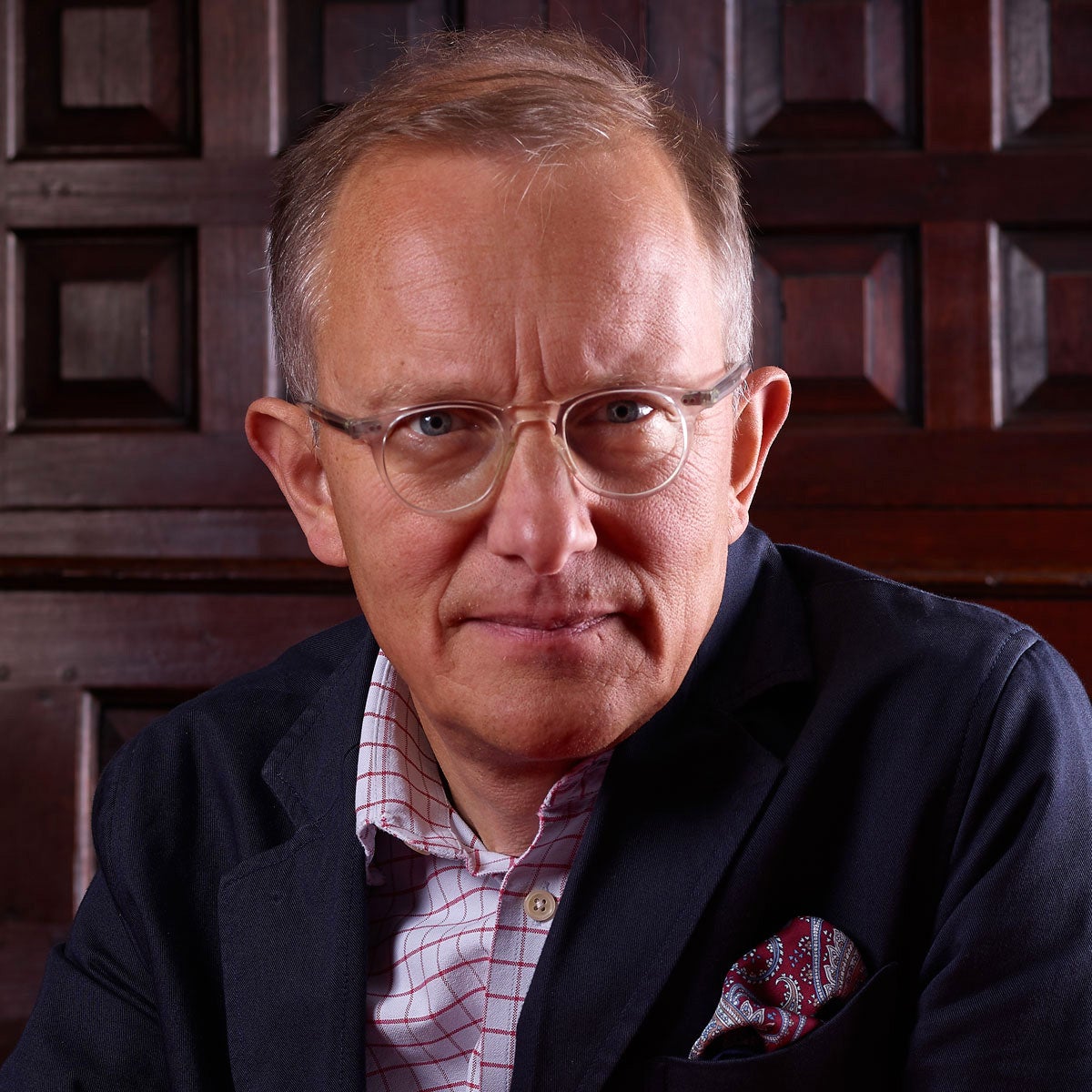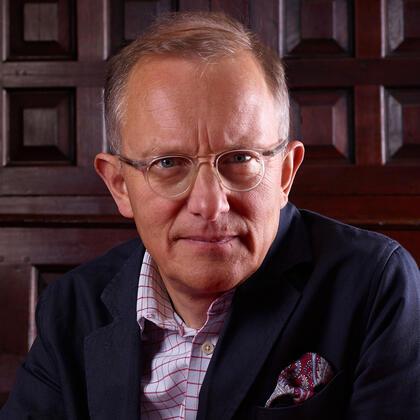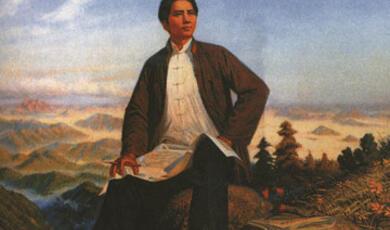Art and Power in the English Aristocratic House
Share
- Details
- Transcript
- Audio
- Downloads
- Extra Reading
The English Aristocracy is often seen as a rural elite concentrating its patronage of art and architecture in the countryside.
This lecture questions this view and shows how, from the sixteenth century, aristocratic families deployed their collections and commissioned their buildings in both town and country in order to further their political and dynastic ambitions.
Download Transcript
20 March 2019
Art and Power in the English Aristocratic House
Professor Simon Thurley
In my lectures this year I am looking closely at the interaction between people, art and architecture. This is not about buildings, about art or about the people that commissioned either, it is about trying to understand how the Tudors and Stuarts thought about what we call art, what it meant to them and what it can teach us about the society they lived in.
In my first lecture I defined art as man-made objects that were not purely utilitarian – things that were made to please the eye as well as serve the hand. Nobody in sixteenth century England, and few in the early seventeenth century, would have thought of art as we do. It was not a category of activity undertaken by artists. making things was a craft and one judged by four criteria that we today would not necessarily recognise as those which would define an artwork.
Just quickly to summarise: these were costliness, probably the first thing people took into account in aesthetic appreciation; craftsmanship which, at the time, was defined as cunning – the skill with which something was made. Then there was novelty, a much-prized characteristic then, as now. Finally, there was placement, the relationship one thing had with another. Sixteenth century writers who commented on what they saw judged everything against cost, cunning, novelty and placement.
But in 1603 a genuinely new era opened in the history of British taste and patronage. The opening up of Europe after the end of prolonged war with Spain re-established artistic links with Italy. A small group of English Aristocrats became obsessed with the art and architecture of Venice, in particular, and began to amass collections of paintings sculpture and other works of art. These objects were judged on a different set of criteria, criteria that were more art historical. We know that Charles I and Inigo Jones loved to play the game of ‘attribute the painting’ – the king removing labels off newly acquired works of art and Jones analysing the canvass and guessing who the painter was
In 1658 a former courtier and Royalist William Sanderson published The most excellent art of painting. This book was a manual on how to choose pictures, discern originals from copies and how to judge whether a work was well painted. His advice extended to how and where to hang pictures including, for instance, that portraits of one’s wife should be hung upstairs in private rooms in case they aroused adulterous thoughts in the mind of ‘an Italian-minded guest’. Sanderson captured in his manual the aesthetic concerns of the circle of connoisseurs round the king.
To be in this exclusive club of connoisseurs you had to be a millionaire and so it was very small. It was also very introverted. The earl of Arundel, the duke of Buckingham, Sutherland, Charles I and Henrietta Maria and their advisors like Inigo Jones and Henry Wotton looked inwards to cabinets, closets and galleries full of art in great mansions and royal palaces and very few outside a charmed circle had any idea what was going on. Art collecting was only between consenting adults in private.
The only glimpse everyone else got was of the Banqueting House ceiling, an epic work of art accessible to more-or-less anyone who wanted to see it. But both the ceiling and the architecture of the building in which it was set were considered the products of a minority interest a court that was doing its own thing.
Tonight, we are going to see how, after around 1680, paintings came much more readily available and how people bought huge numbers to decorate their houses. In fact, in 1691 some 24,000 paintings were offered for sale at London auctions. A detailed analysis of inventories of middle-class houses in the late seventeenth century shows that around half of all residences had around 12 pictures – that would mean some 132,000 paintings were hanging in London houses alone by 1700. This represents a big change in how people decorated their houses, especially given the immediate background. As England plunged into a bloody civil war the famous royal art collection amassed by Charles I was mostly dispersed and sold, and many of his close friends and associates lost their collections through forfeit, sale or destruction. Painting and sculpture came to be regarded as morally and theologically suspect by many and the environment for collecting, let alone for artistic production, was extremely negative. So how do we explain the great upsurge in the purchase of easel paintings and what impact did it have on the buildings of the time?
The Restoration of 1660, like the Treaty of London in 1603, mentioned last time, reconnected England with mainland Europe. This had two aspects to it:
- As Charles II returned to England with him came a large number of people who had been in exile; people who had become accustomed to the ways, attitudes and tastes of people in the Spanish Netherlands, France and Germany. This included new attitudes to what we would call art.
- For the majority of the aristocracy and gentry who had remained in England during the interregnum it provided opportunities to access the artistic products of Catholic Europe that had been denied to them for decade or more.
So let’s start with the first of these: The question of taste. In a post-modern world we hold taste to be a relative value, but in the seventeenth century beauty was an objective quality that could be readily identified and therefore perfect beauty could be achieved. There was fierce debate about how to define, in some way, perfect beauty, but essentially it was believed that because the identification of beauty was all about perception, the education of the beholder was the crucial factor. An educated person would display natural taste, they would be able to perceive true beauty in a painting, sculpture, building or piece of music.
Now this view had important social consequences as education was associated with gentility – the well-off, refined and leisured classes had more time and ability to become educated arbiters of taste. What followed from this was that only the gentle, rich and refined had the ability to discern true beauty and therefore had good taste. Or to put it another way taste and knowledge of painting, sculpture and architecture set the possessor above the multitude.
This was a pervasive attitude that continued through most of the eighteenth century. William Shenstone wrote ‘On the test of Popular Opinion’ in 1764 ‘I think moderately speaking, the vulgar are generally in the wrong. If they happen to be otherwise, it is principally owing to their implicit reliance on the skill of their superiors…’. This was a big change in attitude from that held by the majority at the start of the century. Then a member of the upper gentry could say ‘I’d rather that my son should hang than study letters. For it becomes the sons of gentlemen to blow the horn nicely, to hunt skilfully and elegantly, to carry and train a hawk. But the study of letters should be left to the sons of rustics’. By the mid eighteenth century no gentlemen, let alone an aristocrat, could ignore his cultural education; indeed, the country gentry had become butt of jokes on the metropolitan stage for being ignorant, clumsy, unfashionable and dim-witted. In 1775 a writer in the Connoisseur could state ‘…the rough country squire, whose ideas are wholly bent on guns, dogs, horses and game. His hall must be adorned with stags’ heads, instead of busts and statues; and in room of family pictures, you will see prints of the most famous stallions and racehorses’.
So, by 1700 it was necessary for a gentleman to be a connoisseur of painting but where did the thousands of paintings come to feed this new-found connoisseurship? First, they came from an emerging market in second-hand pictures. Since the late fifteenth century, in order to protect the rights of the guild of Painters and Stainers, it had been illegal to import paintings into the country from abroad. Charles I and his collecting friends had broken this embargo but, from the 1670s it was explicitly recognised that if the import was for personal use, it could be permitted. Though written permission was given for the import of paintings in the 70s and 80s, in 1686 came the first public auction of paintings, held in the Banqueting House and in 1695, a law was finally passed permitting the import of paintings from abroad subject to an import tax of 20%.
At the same time as it became not only possible, but legal, to buy foreign paintings to hang in your house a new native school of painting began to develop. We have to remember that all crafts, and painting was just one of them, were controlled by the monopolistic city craft guilds and the Painters and Stainers had the powers to confiscate paintings done by people other than their members. For centuries foreign painters had got around this rule by living outside the City or at least outside their jurisdiction – Van Dyck, for instance, lived in the Liberty of Blackfriars outside the authority of the guild.
The fact that painters were liverymen confirmed the fact that they, as well as sculptors and architects (who were members of the masons and bricklayers’ guilds) were not regarded as gentleman. Socially they fell into the category of skilled manual classes. Before the Civil War there were few, if any, native painters who were socially acceptable. Anthony Van Dyck was knighted and lived in a large house paid for by the king, and Peter Paul Rubens was a diplomat – but they were foreign. Robert Streeter, Charles II Master Painter, was a capable and versatile artist but as well as painting complex allegories, he decorated ceilings and grained panelling. This pulled down his status in the eyes of society.
One of the few creative and artistic natives to gain acceptance socially was Inigo Jones. But after the Restoration came a class of new gentlemen architects and, in due course, painters. Men like Hugh May, William Samwell and Captain William Winde were gentlemen by birth and made a living from advising on architecture and designing buildings. Later came Wren and Vanbrugh and others. Painters had a harder time; a man like Vanbrugh could leave the drawing of his schemes to a low born, but brilliant, assistant like Nicholas Hawksmoor, a painter could not escape his hands being splattered in oil-paint and smelling of turpentine.
After the restoration a divide began to open up between those who painted coaches, signs, houses and those whose work was more artistic. This was made stark by the fate of the guild of Painters and Stainers. After 1710 they completely lost control of painters working on easel paintings: the group they called face painters or history painters, and the company became solely the regulator of the lower type of mechanical painters. The painter of easel paintings thus started to become what we would call an artist rather than just a purveyor of ingenious images.
In a lecture last year, I described the formation of London’s West End and argued that it was royal initiative that lay at the heart of its origins. It was also royal patronage that began the process of establishing an artistic colony in Covent Garden close to the court. Perhaps the first painter to establish himself there was Robert Streeter who became Charles II’s own painter. But soon the portrait painters of the Restoration court set themselves up there. Peter Lely established what was effectively a portrait factory in a house in the north east side of the Piazza.
Lely, whose brilliant portraits in some ways came to epitomise the Restoration age, first came to London not only to paint but to deal in paintings and sell them. In fact, he shared a house in Covent Garden with a picture dealer. His house contained a studio where he worked but also a series of magnificently furnished rooms to show that he was indeed a gentleman. His walls were hung with great paintings, drawings and prints including this portrait by Van Dyck now in the National Gallery.
Lely’s younger rival was Godfrey Kneller moved in next door in 1718. Other painters in the area included James Thornhill, William van de Velde and Samuel Scott. In fact, any successful painter of the day had, as his ambition, a studio in the Covent Garden Piazza.
One of the key points to remember about this colony of painters is that they all depended on one another and on a circle of expert technicians and suppliers to undertake their work. The famous painters would undertake the face and hands of a portrait, but the sitter’s clothes would be painted by a drapery man who specialised in painting rich textiles worn by wealthy Londoners. Other experts would fill in the background. Nearby also were the colour men who produced the paint, others supplied canvas and made elaborate gilded frames. Also settling nearby were the print sellers who made an industry of translating commercial paintings into prints for mass production.
So’ from the Restoration the fashionable flocked to Covent Garden where they would be painted, view paintings, buy paintings, have them framed and generally be thought of as sophisticated people of taste. Here is Gawen Hamilton’s painting of an MP, Thomas Walker and the painter Peter Monamy in his showroom of about 1735. He is being sold a sea piece, the sort of painting in which Monamy specialised.
This is Francis Haymen painting himself with his patron Grosvenor Bedford in around 1748. The studio contains, frames, canvasses and fine paintings and sculpture showing off the tastes of the artist. Then we have Peter Tillemans much earlier painting (of perhaps 1716) of the artist’s studio…. As these paintings make clear both the painter and the painted were regarded as gentlemen and the artist’s studio was a place of fashion.
A crucial point about the development of the London market for paintings in Covent garden is that the types of painting that were required by the English were much narrower than on the Catholic continent. There, annunciations, assumptions, depositions, holy families, stations of the cross were the bread and butter of any successful painter. In England there was no market for such paintings. Religious art was virtually non-existent. Portraiture and landscape were the staples and were the things that filled people’s houses.
I have said enough now to make the point that by the early eighteenth century it was possible for any gentleman to demonstrate his taste and sophistication by buying at auction a fine painting or going to Covent Garden and commissioning one. In short there was now an art market, anyone with taste and money could furnish their houses with fine pictures.
But now we come to an important distinction. Charles I had a collection, that is to say a large number of paintings assembled more-or-less scientifically representing his artistic interests and the whole comprising, in terms of value and interest, much more than the individual parts. This was a deliberate collection, not just as assemblage of decorative items. There were very few, if any, who, in the 40 years after the Restoration, embarked on creating such a collection. People had paintings and sculpture in their houses and the houses were decorated by them, the paintings gave pleasure and status to the owner and interest and information to his guests.
It was not until the 1740s that you get a situation where aristocrats are making a collection which was, in itself, as important an artistic self-expression as their houses themselves. From this period onwards paintings, sculpture, books, medals, bronzes etc formed one discreet artistic achievement, the house in which they were displayed another and the landscape in which both were set a third. So, during the second quarter of the eighteenth century there was a fundamental change in the status of the things that adorned and decorated the houses of the aristocracy. What counted now was not simply possession of artistic objects, but their selection. A process made possible by the expansion of the London art market after around 1685.
Now, of course, such a change in attitude to possessions had an architectural impact on the houses of the wealthy. At first two types of room became the receptacles of these new collections: the gallery and the closet. We should not be surprised as the first combo of these two rooms was invented by Henry Prince of Wales at St. James’s Palace and then copied by his brother when he became king at Whitehall. So, the fashion was set by the pre-civil war court.
Galleries had long been the place to hang your dynastic portraits but after the Restoration increasingly became the place to hang large numbers of history paintings and landscapes and, in due course, sculpture too. This is a painting of the 5th earl of Carlisle and his son in their gallery at Castle Howard painted by John Jackson. The new gallery is built to take their pictures and, indeed they are inspecting a new acquisition and, no doubt discussing where to hang it. The point about the father and son is the education that is being imparted by the earl to his son and heir.
The cabinet was a small room for things of small size and great value. If you go to Ham House you will still see a cabinet, and one that still contains small pictures and other artistic objects – a unique survival of this type of room. Gradually houses came to have more than one cabinet and separate libraries were built to accommodate books and other smaller treasurers. Indeed, the building of libraries became one of the most important changes in aristocratic houses after 1700. In the seventeenth century books had been generally kept in the owner’s closet, although examples do exist of libraries, again such as that at Ham House where the bibliophile duke of Lauderdale created a new library in 1672-4.
But these places of repository never had the status that was to be later acquired by the galleries, libraries and picture closets of the mid eighteenth century. That is because the interests that the aristocracy had at the Restoration were more scientific. Today this statement might suggest that scientific interests are somehow in opposition, or even the complete opposite, to artistic ones. Arts and sciences toady being different disciplines. But at the Restoration this was not so. Think of Leonardo Da Vinci a century before melding the quest for scientific and artistic truth together.
The courtiers of Charles II were interested in the ingenious, in the curious, and trying to explain it. A wonderfully well-painted picture and the structure of the wing of a fly were both ingenious and demanded explanation. The construction of the dome of St. Paul’s and the manufacture of a powerful telescope were feats of ingenuity that were seen as artistic in nature. People were fascinated by exotic and rare plans and strange and curious animals and wanted to categorise and understand them. This is why all self-respecting gentlemen would have their own laboratories where they could carry out experiments and libraries full of books on a wide range of subjects. Men like Ashmole, Tradescant and Cotton collected to advance knowledge and ingenuity. Here is John Tradescant the Younger with Roger Friend and a Collection of Exotic Shells Thomas de Critz.
Now, in this process that I am describing, there has been a tendency to see painting becoming and remaining the principal and most important artistic expression in great aristocratic houses. And indeed, as I have shown, the status of painting and its availability were transformed after 1685. This is often portrayed as being in strong contrast to the pre-Civil War situation where Textiles and plate remained the most prestigious items. Yet, until at least the mid-eighteenth-century, tapestry remained hugely important. All the major external rooms of aristocratic houses were, by choice, decorated with tapestry. Think of the great rooms at Blenheim Palace, for instance: all the major state room give tapestry pride of place and easel paintings hardly appear at all.
At the Restoration the Mortlake tapestry workshops, established by James I in 1619, were revived with a royal grant of £1,000 a year. This was a large sum of money and showed that, at least in theory, Charles II wanted to re-establish the Crown’s leading place in the manufacture of high-quality tapestry. The workshop was not a success and it is clear that despite the king receiving tapestries from it there was little royal enthusiasm for the venture. But into the vacuum created by the decline of the royal manufactory came numbers of private workshops producing large numbers of tapestries which fed the domestic market. In addition, it was calculated by Francis Poyntz, the king’s official tapestry maker, that in 1678, at least £100,000 worth of tapestry was imported into England. This is a colossal amount in terms of value, and also represented a large number of actual pieces bought from France and the Low Countries. £100,000 was a far greater sum, in value, than was being spent at that time on the import of easel paintings.
So, although the status of painting had risen it was still a more prestigious and expensive choice to hang your greatest rooms in tapestry. This is the signing of the peace of Breda in 1667 a hugely significant international treaty – done in a tapestry covered room. Indeed, there was an interesting period when people mixed the two and hung paintings over the top of tapestry [Fontainebleau]. But let’s return to Blenheim Palace for a moment because as well as the vast tapestry series that were woven for the house, there were rooms painted with illusionistic wall murals. This is the saloon and as you can see the effect of this room is achieved entirely through oil paint.
Now I’m not going to suggest that murals were in any way new in late seventeenth century because, of course, they had adorned the walls of houses and churches for thousands of years. Lord Burghley covered his enormous house at Theobalds in murals in the reign of Queen Elizabeth. However what happened in the 1670s was something new.
There were a number of key taste-makers at the Restoration Court. Perhaps foremost amongst these was Ralph Montagu, later 1st Duke of Montagu who was appointed by Charles II as Ambassador to the court of France. One of the important outcomes of his embassy was the recruitment of the Neapolitan painter and muralist Antonio Verrio who had been working for Louis XIV at Versailles probably under Charles Le Brun. Verrio came to London and painted the great staircase at Montagu House the first great commission in England.
Soon Montagu recommended him to Henry Bennet 1st earl of Arlington. Arlington had a huge country house in Suffolk, Euston Hall, and also, Goring House, the building on the site of Buckingham Palace today. In both his town and his country houses Arlington commissioned Verrio to paint the state rooms. Both houses, like Montagu House, were destroyed by fire so I can’t show you what he painted.
However, at Goring House Charles II saw Verrio’s work and he was transfixed. Some nifty work by Verrio resulted in a spectacular canvass presented to the king to show what he could do in the royal houses.
Verrio waited expectantly. The king’s response is very interesting because initially Verrio was not commissioned to paint interiors but was sent to Mortlake to design a set of tapestries, the traditional high-status interior decoration. But this was not where Verrio’s heart was and Arlington knew that he could do much more. And so he did.
In 1675 through Arlington’s good offices and through his ebullient character which the king liked, as well, of course through his brilliance, Verrio got the commission of a lifetime, to paint twenty ceilings in the king’s new state rooms at Windsor Castle plus two staircases. At Windsor Verrio set the decorative formula that was subsequently applied to hundreds of houses up and down the country. It was an illusion: there was a sky in which gods and goddesses and other complex allegories floated all framed by a painted balustrade that made the break between the wall and the ceiling. This is the ceiling in the Queen’s audience chamber which shows Catherine of Braganza, amidst the clouds, being drawn in a chariot by swans towards a temple of virtue. A zephyr accompanying the Queen carries a crown aloft, whilst a putto carries the Coat of Arms.
In 1680 Charles II commissioned Verrio to paint the two largest and most important rooms at Windsor. Work on the carcass of St. George’s Hall and the Chapel was complete by April 1680 and it was then that the king and Arlington discussed with Verrio the programme for the new rooms. Sketches were made and the surviving modello in the Royal Collection showing the north wall of the Chapel, for instance, would have been agreed by Arlington and presented to the king for approval. There is no doubt that the king liked what he was getting from the painter; he was lavishly rewarded, and on the completion of St. George’s Hall in July 1684, he was given £400 by the king in gratitude.
In its all-over use of trompe l’oiel the two great Windsor interiors was something new in English architecture, but at the same time was very familiar. The Banqueting House, Whitehall, the monarchy’s grandest and largest public space, was covered by an illusionistic painted ceiling and, when hung for great court events, walled in tapestry with big figure scenes in an architectural setting. The effect achieved by Verrio thus ultimately derived from native models and was a quick, effective and, of course, cheap means of achieving a spectacular effect.
But to those who saw it, it was exciting and novel and set the fashion for grand English interiors for the next fifty years. The principle Verrio adopted for the walls was much like the ceiling. The main composition that sort of floated in the air was anchored to the room by illusionistic architectural settings, most normally a screen of columns that made it seem as if you were looking out from the room through a loggia or a portico.
Verrio had some difficulty after the abdication of James II because as a Catholic he was very out of favour with the new regime. This is one of the reasons why he worked in the wilds of Lincolnshire for Lord Exeter at Burghley House. This in my opinion is his surviving masterpiece: the heaven room and hell stairs. The great staircase leading up to the state rooms from the hall is painted as if the viewer is escaping from the jaws of hell. Verrio depicts this as the snarling and snapping mouth of a huge cat with bodies writing in the pain of the fires within. But then the visitor ascends to the first of the state rooms which depicts a classical heaven with the sky crowded by gods.
Here is Blenheim Palace, that we saw a few moments ago; it’s the ceiling of the saloon painted by Verrio’s former assistant Louis Laguerre in about 1720.
Painting these huge murals was no more a one-man job than the portrait studios I described in Covent Garden. There was a supply chain for the materials and there were a host of assistants. In Verrio’s case mostly French and Italian Catholics who had to have special dispensation to work in royal service. The very fact that there were so many assistants meant that the creation of these illusionistic interiors was not confined only to the houses of the aristocracy but quickly permeated to the houses of rich merchants and the upper gentry; there were probably hundreds in London alone. This is a house in Cheyne Walk with a painted staircase directly derived from Verrio’s models of the 1680s. Here is my old house in Stepney Green originally painted almost certainly by Robert Robinson
And this brings me on to an important point. Aristocratic investment in paintings, in the public demonstration of good taste was something that was increasingly exercised in the city rather than the country. Last year I described in my lecture about St. James’s and the West End how, from the 1680s the West End of London had been built by Whig aristocrats. For them the West End was not only a financial investment it was a social one, the very basis of their lives. The richest aristocrats still maintained at least three houses, a principal country house, a town house and a suburban villa. Thus, Philip Yorke and his wife the Marchioness Grey owned Wrest Park, Bedfordshire, a house in St. James’s Square and a villa in Richmond. They moved round the country in a fixed annual routine coming to London in January and February and staying for the season until August when they would leave for the country. London was thus the home of the aristocracy for most of the year and their town and suburban houses were of the utmost importance and splendour.
With such a strong metropolitan focus most aristocrats were too busy to spend time in the country but had to go there because they, with the gentry, ran the localities. This meant that the aristocracy still needed to build mega-houses, a trend that went back through the great Jacobean mansions to the aristocratic houses of the fifteenth century and earlier. Fewer were built from new, but those that were compared well with their predecessors: Castle Howard cost £35,000 and its grounds and park buildings at least another £43,000; building there went on for fourteen years and even then, the house was unfinished.
When in residence aristocrats in these mega houses worked hard at entertaining, seeing to the poor, attending the races and gracing the assembly rooms. But this was work, because Whig aristocratic attitudes were urban, and they really wanted to base themselves and their cultural interests in the metropolis. One of the key reasons for this was that it was there that their great art collections could be admired. It was no use them being in Yorkshire: to be appreciated as a sophisticated patron your best pictures and finest rooms needed to be in London.
Today we might think of Robert Walpole’s amazing collection of paintings that were hung at his country House at Houghton in Norfolk. But the simple fact is that until his fall from power in 1742 all his best paintings were in London where he could show them off. The same went for Chatsworth. Thomas Martyn said in 1766 that Chatsworth ‘had very little in it which can attract the eye of a connoisseur… the pictures in it are few and indifferent’. Turning to Devonshire House in Piccadilly he was to write ‘the collection of pictures with which this house is adorned, is surpassed by very few either at home or abroad’. All the greatest treasures were in London at this period the countryside was reserved for hunting, drinking and talk.
So how do we characterise the patronage of art and architecture in in the seventy years after the Restoration? It was an incredibly vibrant time that saw for the first time the emergence of an English art market. This provided opportunities for a large top-slice of the population to participate in artistic activities, to own paintings and to commission portraits of themselves and their families. It was not really a native industry, it was a happy and exotic mix of English, Italians, Germans and Dutch. A blend of people and ideas that created a distinctive artistic mix.
This is Gawen Hamilton’s ‘Conversation of virtuosos at the King’s Head’ now in the NPG. It’s a very interesting painting which Hamilton raffled amongst the sitters. But that’s not why I’m showing it to you.
- Hamilton at his easel
- Painter Michael Dahl – Swedish
- John Wooton resting on John Michael Rysbrack (Dutch)
- Two engravers, one French, holding a roll of paper
- Also, James Gibbs, Scot
- And William Kent and Charles Bridgeman
This is the art world, cosmopolitan, increasingly professional with a sense of corporate identity as creators, if not artists.
The painting doesn’t only speak of the men, it speaks of their art which was increasingly collaborative. They worked in a period in which the boundaries between the visual arts were broken down and painting and architecture blended into a single art-form. And it was an art form in which a large slice of the upper and middle class now had a stake. People wanted and needed to be well informed about art and architecture and wanted it, in all its forms in their homes.
Lastly this picture shows us an intensely urban scene. These men live and work in London. Some of their commissions may have been for and in the countryside but their milieu is urban and so were the interests of the vast majority of their patrons.
In my next and final lecture in this series I look at the period after the court has ceased to be the centre of architectural patronage and initiative, a period when the collectors and the creators are the aristocrats and explore how this has determined the course of British cultural development.
© Professor Simon Thurley, 2019
Part of:
This event was on Wed, 20 Mar 2019
Support Gresham
Gresham College has offered an outstanding education to the public free of charge for over 400 years. Today, Gresham plays an important role in fostering a love of learning and a greater understanding of ourselves and the world around us. Your donation will help to widen our reach and to broaden our audience, allowing more people to benefit from a high-quality education from some of the brightest minds.


 Login
Login







